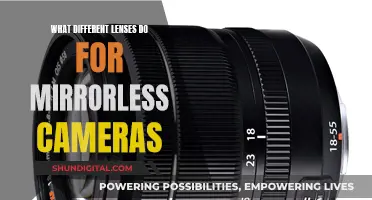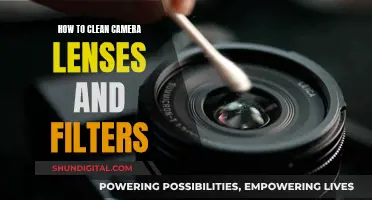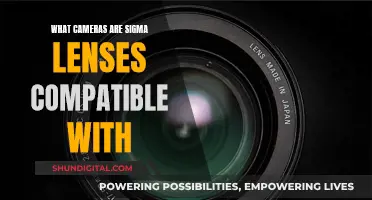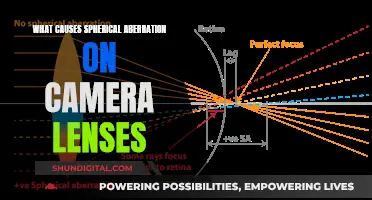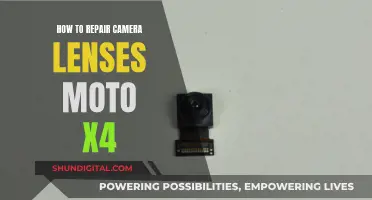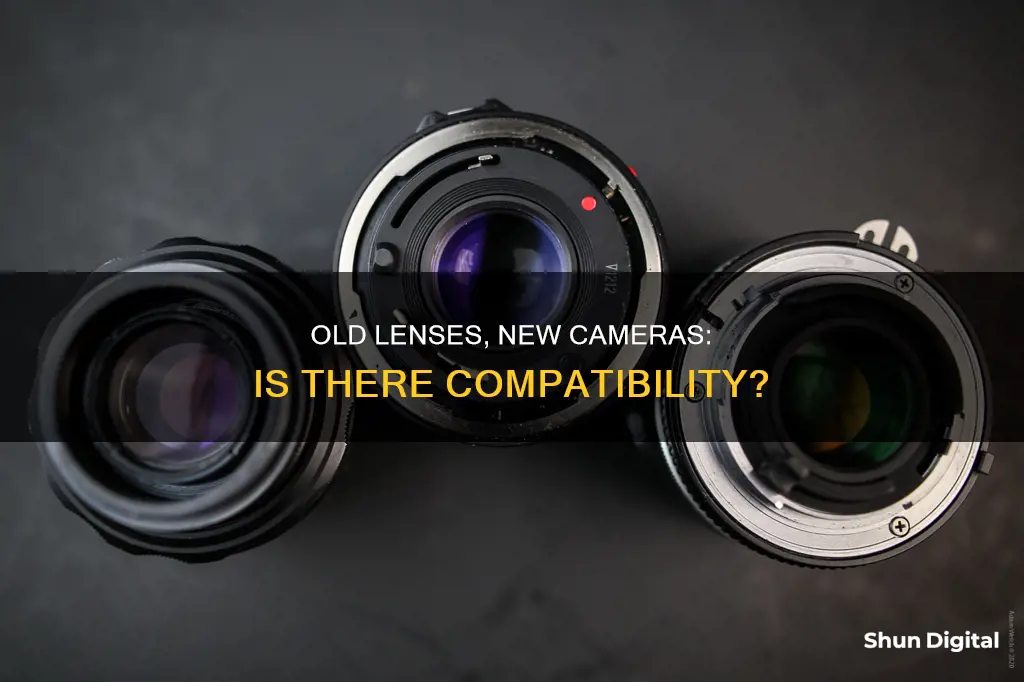
Whether old lenses will fit on new cameras depends on the camera brand and the type of lens. Some camera brands have changed the way their lenses and cameras fit together, so older lenses may not fit or function properly. However, there are lens adapters available that enable old lenses to be used with new camera bodies. These adapters act as connectors, allowing lenses and cameras with different mounts to be physically attached. It is important to ensure that the correct adapter is used, as using the wrong one can damage the camera or lens. Additionally, some old lenses may not have the same resolving power as newer sensors, and there may be optical qualities that are subjectively unpleasant.
| Characteristics | Values |
|---|---|
| Whether old lenses fit on new cameras | Depends on the camera brand and lens mount |
| What to consider when adapting old lenses to new cameras | Lens mount compatibility and flange-focal distance |
| What is flange-focal distance | The distance from the rear mount of the lens to the focal plane of the camera |
| What is needed to adapt old lenses to new cameras | An adapter that converts the lens mount to the camera mount and compensates for the flange-focal distance |
| Pros of using old lenses with new digital cameras | Cost-effective, sharp, well-built, unique character |
| Cons of using old lenses with new digital cameras | Manual focus and aperture adjustments, dust and fungus, infinity focus problem, incompatibility with modern camera features, potential camera damage |
What You'll Learn

Lens mount compatibility
In some cases, lenses and cameras from the same brand may not be compatible due to changes in lens mount designs over time. For example, Canon EF lenses are compatible with any Canon camera with an EF mount, but older Canon "FD" mount lenses made before 1987 will not fit Canon digital SLRs. Nikon, on the other hand, has maintained the same "F mount" coupling for nearly 60 years, allowing most old Nikon lenses to fit their modern digital SLRs, although some functions may not be available.
When dealing with lenses and cameras from different brands, the likelihood of direct lens mount compatibility decreases. For example, a Canon lens will not natively fit on a Nikon camera as the companies have intentionally designed their lenses to be incompatible. However, it is still possible to adapt lenses from one system to another using lens adapters.
Lens adapters are designed to convert the lens mount of a lens to match the mount of the camera body, enabling physical attachment and proper focus. These adapters come in various forms, from simple metal rings to more complex electronic adapters, and can be used to adapt lenses from one brand to another or from an older film system to a newer digital system. It is important to choose an adapter that not only converts the lens mount but also correctly compensates for the flange-focal distance, ensuring proper focus.
While lens adapters provide a solution for physical compatibility, it is important to note that not all functions may be available when using old lenses on new cameras. For example, autofocus and aperture control may be lost when using old manual-focus lenses on modern cameras, requiring manual adjustments. Additionally, older lenses may not have the resolving power to take full advantage of newer sensors, potentially impacting image quality.
Lens and Camera Compatibility: Universal Fit or Not?
You may want to see also

Flange-focal distance
The flange-focal distance is an important consideration when adapting older lenses for use with digital cameras. Without the correct flange-focal distance, the adapted lens may not be able to focus correctly or at all. The flange-focal distance is extremely simple to understand: it is the distance (in millimetres) from the rear mount of the lens to the focal plane of the camera, which can be either film or a digital sensor. The focal plane is designated by a symbol that looks like a '0' with a line.
Different cameras have different flange-focal distances, which vary widely between manufacturers. Compensating for this difference in flange-focal distance is a key factor in determining whether the adapted lens will be able to obtain the correct focus. Therefore, a lens adapter needs to act not only as a mount converter but also accurately correct for the specified focal-flange distance.
When adapting lenses from one mount to another, it is generally easier to adapt lenses with a larger flange-focal distance to cameras with a smaller flange-focal distance. For example, a Canon DSLR with a flange-focal distance of 44mm can be easily adapted to a Sony mirrorless camera with a flange-focal distance of 18mm. In this case, the adapter would need to provide 26mm of spacing to achieve the correct flange-focal distance of the Canon lens.
It is important to note that some lens adapters do not take flange-focal distance into account, which can result in incorrect or non-existent focus. Additionally, using old lenses with modern cameras may come with other complications, such as dust, fungus, and infinity focus problems. It is crucial to be careful when adapting lenses to avoid potential damage to the camera or lens.
Cameras and Lenses: Separate but Interdependent Pieces
You may want to see also

Manual focus and aperture
Additionally, manual focus and aperture can be beneficial in certain shooting situations. For instance, if you are photographing landscapes or still life scenes, manual focus can be very effective since your subjects are not moving.
However, it is important to note that manual focus and aperture may not be ideal for capturing moving subjects or situations where you need to work quickly. In these cases, autofocus and automatic aperture can be more convenient and help ensure you don't miss the shot.
Bigger Camera Lenses: Do They Make a Difference?
You may want to see also

Autofocus and aperture control
When using old lenses on new cameras, autofocus and aperture control are two important factors to consider. While it is possible to use old lenses on new cameras, there may be some limitations and adjustments required.
Autofocus
Autofocus may not work when using old lenses on new cameras. In most cases, you will need to focus manually by hand, even if the new camera body has autofocus capabilities. This can be challenging, especially for photographing moving subjects or when using non-professional digital SLRs with small, dim viewfinders.
However, there are some adapters available that can enable autofocus or provide focus indicator chips that communicate with the camera when the selected point of focus is obtained. These adapters may be preferred by those who are against manual focus.
Aperture Control
When using old lenses on new cameras, you will also need to adjust the aperture manually using the aperture ring on the lens barrel. This can be a new experience for those who are used to having the camera control the aperture automatically.
It is important to choose an adapter that allows you to control the aperture of your lens. Adapters that do not offer this functionality can be a pain to use and may limit your creative options.
In summary, while it is possible to use old lenses on new cameras, you may need to make some adjustments and accept some limitations, especially regarding autofocus and aperture control. Manual focus and aperture adjustments can be a rewarding experience, as they encourage you to think more deliberately about your composition and allow you to experience the effects of aperture adjustments firsthand.
Lens Compatibility: Understanding Camera Lens Interchangeability
You may want to see also

Image circle
The image circle is an important consideration when adapting old lenses to new camera bodies. The image circle refers to the size of the circle of light cast by a lens onto the camera's sensor or film. If the image circle is too small for the camera's sensor, the lens will not be compatible and may even damage the camera.
For example, if a lens with a full-frame image circle is mounted on an APS-C sensor, the image will appear zoomed-in, as the smaller sensor captures only the centre of the image circle. This effect is similar to cropping the image. Conversely, mounting a lens designed for a smaller sensor onto a full-frame camera will result in a significant portion of the frame appearing black, as the image circle does not cover the entire sensor.
When adapting old lenses to new cameras, it is crucial to ensure that the lens produces an image circle large enough to cover the camera's sensor. This compatibility issue is particularly relevant when adapting lenses designed for film cameras to digital sensors, as the image circles of these lenses may not be large enough to cover the larger sensors found in many modern digital cameras.
It is also worth noting that some adapters may not compensate for the correct flange-focal distance, which is the distance from the rear mount of the lens to the camera's focal plane. This can result in focus issues, including the inability to focus to infinity. Therefore, when choosing an adapter, it is important to ensure that it provides the correct flange-focal distance for your specific lens and camera combination.
Camera Lenses: Sales, Deals, and Discounts
You may want to see also
Frequently asked questions
It depends on the camera brand and model. Some newer camera bodies have different lens mounts and flange-focal distances, requiring an adapter to fit old lenses.
The flange-focal distance is the distance from the rear mount of the lens to the focal plane of the camera. Different camera systems have different flange-focal distances, and if this distance is not properly compensated for by the adapter, the lens will not be able to focus correctly.
Yes, old lenses may have dust, fungus, or other issues that can affect image quality. Additionally, manual focus and aperture adjustments may be required with older lenses, and autofocus or electronic functions may not work with newer camera bodies.



